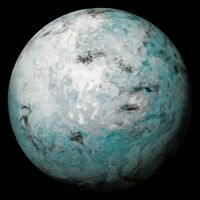Tsanfau II: Difference between revisions
Jump to navigation
Jump to search
No edit summary |
No edit summary |
||
| Line 42: | Line 42: | ||
Tsanfau II is the second-largest moon of Tsanfau. It is about 690 kilometers (428 mi) in diameter. Tsanfau II is mostly covered by freshly created and relatively clean ice sheets, exposed rocky mountaintops, old craters, ice scraps, ice geysers, water-ice layers, and a surprisingly dense atmosphere for its size. | Tsanfau II is the second-largest moon of Tsanfau. It is about 690 kilometers (428 mi) in diameter. Tsanfau II is mostly covered by freshly created and relatively clean ice sheets, exposed rocky mountaintops, old craters, ice scraps, ice geysers, water-ice layers, and a surprisingly dense atmosphere for its size. | ||
==History== | |||
===Discovery=== | |||
===Naming=== | |||
==Orbit and rotation== | |||
==Geology== | |||
===Surface features=== | |||
====Impact craters and Mountains==== | |||
====Tectonic features==== | |||
====Smooth Ice plains==== | |||
====polar regions==== | |||
====ice geysers and plumes==== | |||
===Internal structure=== | |||
====Subsurface water ocean==== | |||
====Composition==== | |||
===Possible heat sources=== | |||
====Tidal heating==== | |||
====Radioactive heating==== | |||
====Chemical factors==== | |||
===Atmosphere=== | |||
==Shape and size== | |||
Revision as of 02:08, 11 January 2022
 | |
| Discovery | |
|---|---|
| Discovered by | Allister Llloyd |
| Discovery date | 15 November 1799 at the
Layfet Colonial Observatory, Layfet, |
| Designations | |
| MPC designation | Tsanfau II |
| Orbital characteristics | |
| Satellite of | Tsanfau |
| Physical characteristics | |
Mean radius | 344/5 km |
| Mass | 1.911E+20 |
Mean density | 1.116 g/cm^3 |
| 0.107 m/s^2 | |
| 272.1 m/s | |
| Atmosphere | |
| Composition by volume | 78% methane (CH4), 5% ammonia (NH3), 5% water (H20) 5% ammonium hydrosulfide (NH4SH) 5% methane hydrate, 2% trace other gases |
Tsanfau II is the second-largest moon of Tsanfau. It is about 690 kilometers (428 mi) in diameter. Tsanfau II is mostly covered by freshly created and relatively clean ice sheets, exposed rocky mountaintops, old craters, ice scraps, ice geysers, water-ice layers, and a surprisingly dense atmosphere for its size.